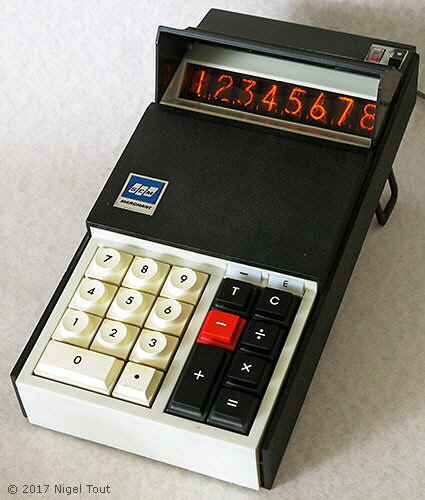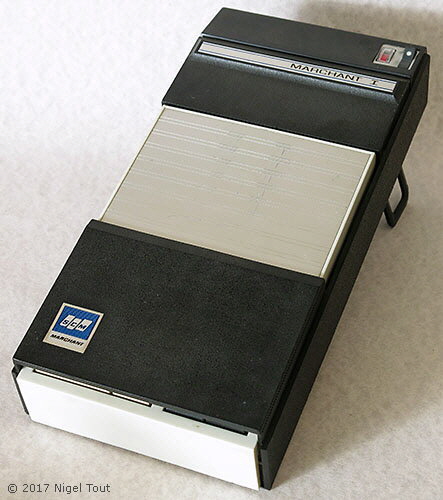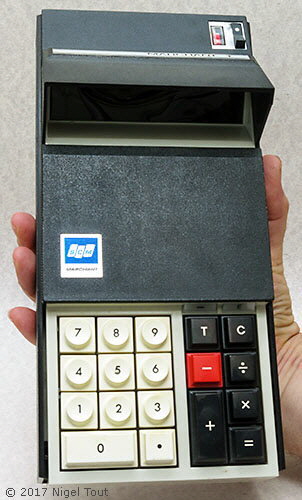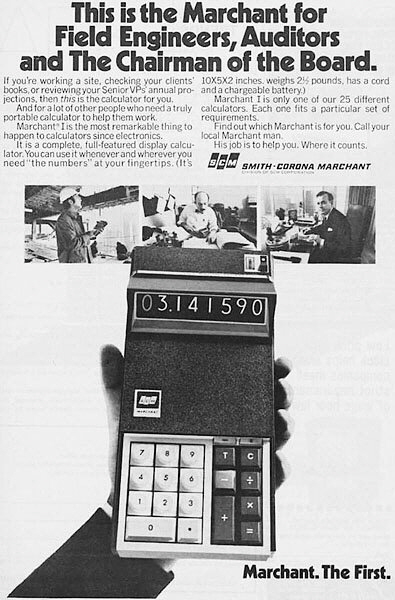SCM Marchant I

Smith-Corona-Marchant (SCM) Marchant I
Distinctive features: One of the first hand-held, battery powered calculators. Has battery charge meter. Has an ingenious sliding cover over the keyboard with a mechanism linking it to the display cover and the power switch.
Technical details:
Display is 8 digits "Nixie"-type tubes.
Four-functions.
The keyboard, unusually, has a 'T' (Total) key. Although the '=' key is used as expected with multiplication or division, for addition and subtraction the result is placed in the Total register and is transferred to the display using the 'T' key.
6v nickel-cadmium rechargeable battery.*
121 mm x 257 mm x 52 mm (4.8" x 10.2" x 2.0"), 1.1 Kg (2.4 lbs).*
Circuitry: MOS LSI (Metal Oxide Semiconductor, Large Scale Integration).*
Either 2x edge-mounted chips from American Micro-systems Inc. (AMI)[1], or 3x edge-mounted chips from Texas Instruments (TI), see journal extracts below.
Operation time:*
Addition - less than 1/100 second.
Subtraction - less than 1/100 second.
Multiplication- 4/100 to 3/10
second.
Division - 7/100 to 1/3 second.
Made in Oakland, California, U.S.A.*
Launched in autumn 1970[2].
Cost: US$495[2].
Smith-Corona-Marchant was a major manufacturer of advance mechanical calculators which moved into electronic calculators until it was hit by the plunging price of calculators and exited that market in 1973.
* Specification from the Operating Manual.


The machine shut down with the cover having been slid over the keyboard, which shuts the display cover and turns off the calculator.
Sliding the cover up reveals the keyboard, opens the display
cover and turns on the calculator.
The Marchant I is a bit of a handful.
The journal Electronics reported on the chips in the Marchant I[3]:
'... as AMI uses two and TI three
American Micro-systems Inc. of Santa Clara, Calif., considered the largest MOS producer, also has been looking at one-chip calculator designs [as well as Busicom/Mostek]. AMI has decided that, though such a machine is possible and feasible, it's not economical now. "The cost effectiveness of of an MOS calculator
is no longer dependent on the MOS circuits; its the display [that counts]," says one executive. "But if a customer really wanted one, we could do it and deliver it in 20 weeks."
For example, when SCM
asked AMI to make the MOS circuits for its Marchant I machine, the original goal was a single chip. According to Fred Jenkinson, director of engineering at the New York-based Smith-Corona-Marchant division of SCM, "we had
considered a one-chip machine, but AMI showed us that the best cost situation would be achieved with a two-chip design."
And while AMI is manufacturing the chips for the machine, SCM wanted a second
source. Jenkinson says that it's difficult to get one MOS manufacturer to second-source someone else's chips, "so we went through the whole design procedure again with TI [Texas Instruments]." The Dallas firm is providing the same functions—add, subtract, multiply, and divide with eight-digit display and a register
that allows chain calculations—on three chips. So although the machines may look and function the same, they are different inside.
Alan E. Pound, an AMI technical staffer and one of the SCM chip
designers, says that no breakthrough was required to get all of the electronics (except for the display driving circuitry, which most companies prefer to leave out) on the chips. "We can get three times as much logic on an
equivalent size chip as we did two years ago. We're smarter in laying out the chip—they are laid out by hand, which is the best way to lay out general logic." However, AMI did employ some computer-aided design in
calculating individual device geometry.
The circuit-packing capability of the AMI design is very apparent when the three TI chips are compared to the two AMI units—each of the AMI devices is smaller than
any of TI's.
Says a TI spokesman regarding the comparative chip density: "SCM requested a design that was already partitioned into three chips and TI furnished it per the specifications."
Although such "second-sourcing" of electronic components was common in industry it was very unusual in the calculator business where developments at the time were very rapid and the cost of components was dropping rapidly.

Advertisement for the Marchant I from April 1971.
References:
Hand-held Calculators
Vintage Calculators
Text & photographs copyright, except where stated otherwise, © Nigel Tout 2000-2025.